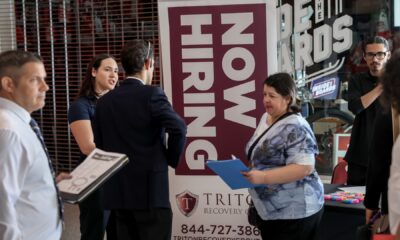Private-job creation burst to its highest level in more than a year during October, despite a devastating storm season in the Southeast and major labor disruptions, ADP reported Wednesday.
The payrolls processing firm said companies hired 233,000 new workers in the month, better than the upwardly revised 159,000 in September and far ahead of the Dow Jones estimate for 113,000. ADP said it was the best month for job creation since July 2023.
“Even amid hurricane recovery, job growth was strong in October,” ADP chief economist Nela Richardson said. “As we round out the year, hiring in the U.S. is proving to be robust and broadly resilient.”
The numbers counter expectations for a slowdown in October on the heels of two brutal hurricanes — Helene and Milton — that ravaged the Southeast, with Florida and North Carolina getting slammed in particular.
On top of that, labor disruptions with port workers and Boeing were expecting to hit payrolls as well, with some economists suggesting that October would be an outlier report that Federal Reserve officials would largely dismiss when meeting next week.
However, the ADP report indicates that the labor market has held up. In addition to hiring rising, wages grew 4.6% from a year ago.
Moreover, gains were widespread. Leading sectors included education and health services (53,000), trade, transportation and utilities (51,000), construction and leisure and hospitality, which added 37,000 apiece, and professional and business services, which contributed 31,000.
Manufacturing was the only sector to report losses, down 19,000 on the month, as the Boeing strike since Sept. 13 has sidelined 33,000 of the company’s workers.
Job creation was strongly concentrated in companies with 500 or more employees, which added 140,000 of the total. Businesses with fewer than 50 workers were little changed, contributing just 4,000 of the total.
The ADP report traditionally tees up the more closely watched nonfarm payrolls count from the Bureau of Labor Services. That report, which comes Friday, is projected to show growth of just 100,000 and an unemployment rate holding steady at 4.1%.
However, the ADP and BLS reports can differ substantially, with the latter including government workers. The BLS report showed private job gains of 223,000 in September and 254,000 total payrolls growth.

 Economics1 week ago
Economics1 week ago
 Accounting1 week ago
Accounting1 week ago
 Blog Post5 days ago
Blog Post5 days ago
 Economics1 week ago
Economics1 week ago
 Personal Finance1 week ago
Personal Finance1 week ago
 Economics6 days ago
Economics6 days ago
 Personal Finance1 week ago
Personal Finance1 week ago
 Finance1 week ago
Finance1 week ago






















